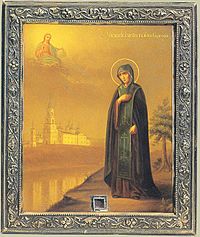Anna of Kashin facts for kids
Quick facts for kids SaintAnna of Kashin |
|
|---|---|

Anna of Kashin praying to the Saviour in Clouds, icon about 1910
|
|
| Venerable | |
| Born | c. 1285 presumably Rostov the Great |
| Died | 2 October 1368 (aged 82–83) borough near Kashin |
| Venerated in | Russian Orthodox Church |
| Canonized | 1650 by Russian Orthodox Church |
| Major shrine | relics in Kashin |
| Feast | 24 June (opening of her relics) |
| Patronage | Town of Kashin |
|
Catholic cult suppressed
|
1677 12 June 1909 cultus reestablished |
Saint Anna of Kashin (Russian: Святая Анна Кашинская) was a Russian princess who lived from about 1285 to 1368. She was part of the Rurik Dynasty, a very old and important family that ruled Russia for many centuries. Anna was later recognized as a saint in 1650. She is remembered for her strong faith and for facing many difficult times in her life.
Contents
Anna's Early Life and Marriage
Anna was the daughter of Prince Dmitry Borisovich of Rostov. She grew up learning about Christianity and was taught to be humble and obedient. Her teacher was Saint Ignatius, a bishop known for his kindness and peaceful ways. Like other princesses of her time, Anna also learned skills like needlework.
When she was older, Princess Xenia of Tver arranged for Anna to marry her son, Prince Mikhail. Their wedding took place on November 8, 1294, in Tver. To celebrate, the people of Kashin built a church and special gates named "Mikhaylovsky" after the prince.
Anna's Children
Anna and Mikhail had five children together:
- Feodora (who died as a baby)
- Prince Dmitry of Tver (1299–1326)
- Prince Alexander of Tver (1301–1339)
- Prince Konstantin of Tver (1306–1346)
- Prince Vasily of Kashin (died after 1368)
Challenges and Tragedies
Anna's life was full of challenges. In 1295, a big fire destroyed Tver. Soon after, her first child, Feodora, passed away. Another fire in 1296 almost trapped Anna and Mikhail in their palace.
Later, her husband, Prince Mikhail, faced a war with Prince Yury of Moscow. In 1318, Mikhail was called to the Horde, a powerful group that ruled many lands. Sadly, he was tortured and died there. Anna learned about his death almost a year later. She arranged for his body to be brought back to Tver and buried.
More sadness followed. In 1325, her eldest son, Dmitry, also died while at the Horde. In 1327, her second son, Alexander, fought against the Tartar army, who then destroyed Tver in revenge. Alexander had to hide for ten years. In 1339, Alexander and his son Feodor were also killed by the Horde.
Life as a Nun
After losing her husband and several children, Anna decided to dedicate her life to God. She became a nun at a monastery in Tver and took the name Evfrosiniya.
In 1365, her youngest son, Vasily, who was her only child still alive, asked her to move to his principality in Kashin. A new monastery was built there, and Anna became a nun again, this time taking the name Anna. She passed away peacefully from old age on October 2, 1368, and was buried in a cathedral.
Becoming a Saint
For many years, Princess Anna's story was not widely known. However, during a siege of Kashin by Lithuanian troops in 1611, it is said that Anna appeared to a church worker named Gerasim. She reportedly prayed for the city to be saved from the invaders. After this, people believed her remains could perform miracles.
In 1650, the Russian Orthodox Church officially recognized her as a saint. This meant people could honor her and pray to her.
A Disagreement About Her Status
About 28 years later, the Church decided to stop her official recognition as a saint. This was partly because of how some groups, called the Old Believers, honored her. On icons, Anna was shown making the Sign of the Cross with two fingers. The Old Believers also used two fingers for this sign, while the official Church had changed to using three fingers.
The Old Believers saw Anna's two-fingered sign as proof that their way was correct. Even when the Church tried to change the position of her hand on her remains, it reportedly went back to the two-fingered position. Because of this, her remains were removed from public view.
In 1678, the Church held a meeting and decided that people should no longer pray to Anna, but only pray for her.
Reinstatement as a Saint
It wasn't until June 12, 1909, that the Russian Orthodox Church officially recognized Anna as a saint again. This allowed people to celebrate her and honor her once more. That same year, a religious community was named after her in Grozny, and a church was built in her name in St Petersburg a year later.
See Also
- List of Russian saints

